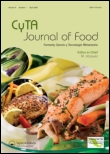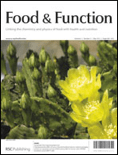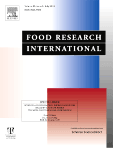
Food Frontiers
Scope & Guideline
Pioneering Research in Food Safety and Sustainability
Introduction
Aims and Scopes
- Nutritional Science and Health Effects:
The journal focuses on the nutritional aspects of foods, including their bioactive components and their effects on health, metabolism, and disease prevention. - Food Safety and Quality Control:
Research related to food safety, including detection of contaminants, foodborne pathogens, and the development of preservation methods to enhance the quality and safety of food products. - Functional Foods and Bioactive Compounds:
Exploring the role of functional foods and natural compounds in health promotion, disease management, and their mechanisms of action within the body. - Microbiota and Gut Health:
Investigating the interactions between diet, gut microbiota, and overall health, including the impact of dietary components on gut microbiota composition and function. - Food Processing and Technology:
Research on innovative food processing techniques and their effects on food properties, nutritional value, and safety, including the application of nanotechnology and other advanced methods. - Cultural and Societal Aspects of Food:
Examining the social, cultural, and economic factors influencing food choices, consumption patterns, and the acceptance of novel food sources.
Trending and Emerging
- Gut-Brain Axis and Microbiota Research:
There is an increasing focus on the gut-brain axis and the role of gut microbiota in influencing mental health, cognitive function, and overall well-being. - Functional Foods Targeting Specific Health Issues:
Emerging research is centered on developing functional foods that target specific health conditions, such as metabolic disorders, cardiovascular diseases, and cognitive decline. - Sustainable and Innovative Food Sources:
Research is trending towards exploring alternative food sources, including insects and plant-based foods, as sustainable options to meet global food demands. - Nanotechnology in Food Science:
The application of nanotechnology in food preservation, safety, and delivery systems is gaining traction, with several studies exploring its potential benefits. - Interdisciplinary Approaches to Food Research:
There is a growing trend towards interdisciplinary research that combines food science, nutrition, microbiology, and psychology to address complex health issues. - Personalized Nutrition and Dietetics:
Emerging themes in personalized nutrition, focusing on how individual variations in genetics and microbiota affect dietary needs and responses, are becoming increasingly relevant.
Declining or Waning
- Traditional Food Preservation Techniques:
Research focusing on conventional preservation methods is decreasing as newer technologies and approaches gain prominence in the field. - Basic Nutritional Studies:
Studies that primarily focus on basic nutritional composition without exploring functional or health-related implications are becoming less common, as there is a greater emphasis on applied research. - Single Food Component Studies:
Research focusing on the effects of single food components in isolation is waning in favor of more integrative approaches that consider complex food systems. - Animal Studies with Limited Human Relevance:
While animal studies remain important, there is a trend towards prioritizing research that has direct implications for human health, leading to a decrease in studies with limited translational value.
Similar Journals

NFS Journal
Transforming the landscape of food science and dietetics.NFS Journal, published by ELSEVIER, is at the forefront of research in the fields of Food Science and Nutrition and Dietetics, boasting an impressive impact factor that underscores its significance. With an Open Access model since 2015, the journal facilitates widespread dissemination and accessibility of high-quality research, making it a valuable resource for scholars and practitioners alike. Located in Germany, this journal has made its mark with its prestigious Q1 ranking in both Food Science and Nutrition and Dietetics as of 2023, positioning it among the top-tier journals in these disciplines. Additionally, it holds an outstanding standing in Scopus rankings, being placed at 10th out of 140 in Nutrition and Dietetics and at 27th out of 389 in Food Science, reflecting its influence and reach within the global academic community. The NFS Journal is dedicated to publishing the latest advancements and practices that shape our understanding of the relationship between food, health, and nutrition, appealing to researchers, professionals, and students eager to stay updated with novel insights and breakthroughs.

FOOD TECHNOLOGY AND BIOTECHNOLOGY
Transforming Ideas into Impactful Food InnovationsFOOD TECHNOLOGY AND BIOTECHNOLOGY is a distinguished peer-reviewed journal published by the Faculty of Food Technology and Biotechnology, University of Zagreb, Croatia. Since its inception in 1993, this Open Access journal has become a crucial platform for disseminating innovative research in the fields of food science, biotechnology, and chemical engineering. With a commendable impact factor and consistent Q2 and Q3 rankings across multiple categories—including Biotechnology, Food Science, and Industrial Engineering—this journal not only fosters academic discussions but also addresses real-world challenges in food production, safety, and sustainability. As it converges its thematic scope from 1996 to 2024, FOOD TECHNOLOGY AND BIOTECHNOLOGY remains committed to advancing knowledge through high-quality research and interdisciplinary collaboration, making it an essential resource for researchers, professionals, and students seeking to stay at the forefront of food innovation and biotechnology.

Ukrainian Food Journal
Celebrating the richness of Ukrainian culinary science.Ukrainian Food Journal is an esteemed open-access journal dedicated to advancing the field of food science and biochemistry. Established in 2012 and published by the National University of Food Technologies in Ukraine, the journal serves as a vital platform for researchers and professionals to disseminate their findings on food technology, safety, and nutritional biochemistry. With an ISSN of 2304-974X and E-ISSN 2313-5891, it offers a wealth of knowledge to its readers, promoting innovation and collaboration within the industry. While currently categorized within the Q4 quartile of biochemistry and the Q3 quartile of food science, the journal is progressively gaining recognition, reflecting a commitment to quality research in a competitive field. The journal is indexed in Scopus, ranking #271 in Food Science and #376 in Biochemistry, underscoring its relevance and contribution to agricultural and biological sciences. The Ukrainian Food Journal not only enriches the academic community with its open-access model but also aims to foster dialogue among researchers, professionals, and students dedicated to improving food systems and nutrition. It operates from its headquarters in Kyiv, offering a hub for creativity and advancement in food-related research.

CyTA-Journal of Food
Connecting researchers to enhance global food systems.CyTA-Journal of Food is a prestigious academic journal published by TAYLOR & FRANCIS LTD, dedicated to advancing the field of food science and technology through the dissemination of innovative research and practical knowledge. With an ISSN of 1947-6337 and an E-ISSN of 1947-6345, this journal stands out with its strong impact factor and is currently placed in the Q2 quartile across multiple categories, including Chemical Engineering, Chemistry, and Food Science, making it a vital resource for researchers and professionals alike. The journal has been an integral part of the academic community since its inception in 2009, and continues to publish cutting-edge articles through to 2024. Its alignment with Scopus ranks further signifies its influence, notably achieving 67th percentile in Industrial and Manufacturing Engineering. As an Open Access journal, it ensures widespread accessibility to its valuable content, promoting collaboration and knowledge sharing among scientists, engineers, and students dedicated to enhancing food safety, quality, and sustainability.

Journal of Food Science and Technology-Ukraine
Empowering Food Scientists with Accessible KnowledgeJournal of Food Science and Technology-Ukraine, published by the Odesa National University of Technology, stands as a pivotal platform dedicated to the dissemination of high-quality research in the field of food science and technology. With its open access policy established in 2014, the journal fosters global knowledge sharing and accessibility, enabling researchers, professionals, and students to access critical findings and advancements in food technology without barriers. The journal's commitment to publishing innovative studies, reviews, and case analyses reinforces its role in addressing contemporary challenges in food safety, preservation, processing, and nutritional quality. With ISSN 2073-8684 and E-ISSN 2409-7004, it serves as a valuable resource for the academic community, supporting the advancement of food science knowledge and its practical applications.

INTERNATIONAL JOURNAL OF FOOD SCIENCES AND NUTRITION
Pioneering research for a healthier tomorrow.International Journal of Food Sciences and Nutrition, published by Taylor & Francis Ltd, is a premier, peer-reviewed journal that has established itself as a leading platform for the dissemination of cutting-edge research in the field of food science and nutrition. With an impressive Q1 categorization and an academic rank of #59/389 in Scopus’s Agricultural and Biological Sciences category, this journal is recognized for its significant impact, facilitating critical discussions and advancements related to food quality, safety, and nutritional health. Its historical significance, covering research from as early as 1947 to the present day, underscores the journal's long-standing commitment to scientific rigor and innovation. Researchers and professionals benefit from this journal's comprehensive and diverse range of studies, contributing to informed practices and developments in the food industry and public health. Although the journal is not open access, it provides various access options, ensuring that high-quality research is available to academics and practitioners alike. Stay connected with current trends and breakthroughs in food sciences and nutrition through this highly respected publication.

npj Science of Food
Innovating Solutions for Sustainable Food Systemsnpj Science of Food is a premier journal published by NATURE PORTFOLIO, focusing on groundbreaking research in the fields of Food Science and Public Health. Since its inception in 2017, this Open Access journal has rapidly established itself as a vital resource for researchers and professionals alike, contributing significantly to advancements in scientific knowledge related to food safety, sustainability, and nutritional health. With an impressive Q1 ranking in both Food Science and Public Health for 2023, and a Scopus ranking placing it in the top 12% of related fields, the journal serves as a critical platform for disseminating high-quality research. Situated in the United Kingdom and operating with a global perspective, npj Science of Food encourages the publication of innovative and interdisciplinary studies aimed at addressing real-world challenges in food systems and human well-being. Researchers, professionals, and students looking to stay at the forefront of food science can access a wealth of knowledge and insights through this impactful journal.

Foods
Uniting Disciplines for Comprehensive Food Insights.Foods is a premier open access journal published by MDPI, based in Switzerland, that has been at the forefront of disseminating high-quality research in the fields of food science, health professions, and plant science since its establishment in 2012. With an impressive convergence of interdisciplinary studies spanning various aspects of food, nutrition, and microbiology, the journal aims to provide a comprehensive platform for researchers and professionals to share innovative ideas and findings. Maintained as a Q1 journal in multiple categories for 2023, including Food Science and Health Professions, Foods has garnered significant recognition within the academic community, reflected in its strong Scopus rankings and percentiles across various disciplines. The journal not only promotes open access to enhance the visibility and accessibility of research but also encourages the exploration of sustainable food systems and health-related issues, thus contributing to essential discussions in today's society. For those looking to advance their understanding and expertise in food-related sciences, Foods serves as an enduring resource for groundbreaking studies and critical insights.

Food & Function
Transforming Food Research for Better LivingFood & Function, published by the Royal Society of Chemistry, is a premier journal dedicated to advancing the understanding of food science and its intersection with health and nutrition. With an impressive impact factor and classified in the Q1 quartiles for both Food Science and Medicine (Miscellaneous) as of 2023, this journal stands at the forefront of research dissemination in its field. Established in 2010 and continuously evolving through to 2024, Food & Function presents a broad spectrum of innovative and impactful articles that explore the physiological effects of food components, nutritional science, and the functional properties of food. With a Scopus ranking in the 91st percentile for Agricultural and Biological Sciences, it serves as an invaluable resource for researchers, professionals, and students alike, seeking to explore the intricate relationship between diet and well-being.

FOOD RESEARCH INTERNATIONAL
Exploring Innovations in Food Safety and QualityFOOD RESEARCH INTERNATIONAL is a premier academic journal published by ELSEVIER, specializing in the field of Food Science. With an impressive impact factor and ranked Q1 in the 2023 category quartiles, it stands at the forefront of research, positioned 17th out of 389 in the Scopus ranking for Agricultural and Biological Sciences, attaining a commendable 95th percentile. The journal publishes high-quality, peer-reviewed articles that cover a broad spectrum of topics, including food safety, quality control, nutrition, and biotechnology, making it an invaluable resource for academics, industry professionals, and students alike. As FOOD RESEARCH INTERNATIONAL seeks to enhance understanding and advance technologies related to food, it encourages innovative perspectives and interdisciplinary research. The journal, active from 1992 and continuing through 2024, is an essential platform for disseminating vital findings and fostering collaboration within the global food science community.